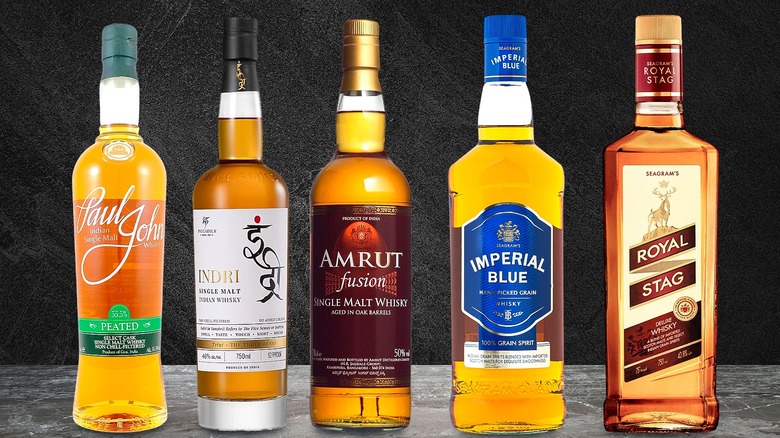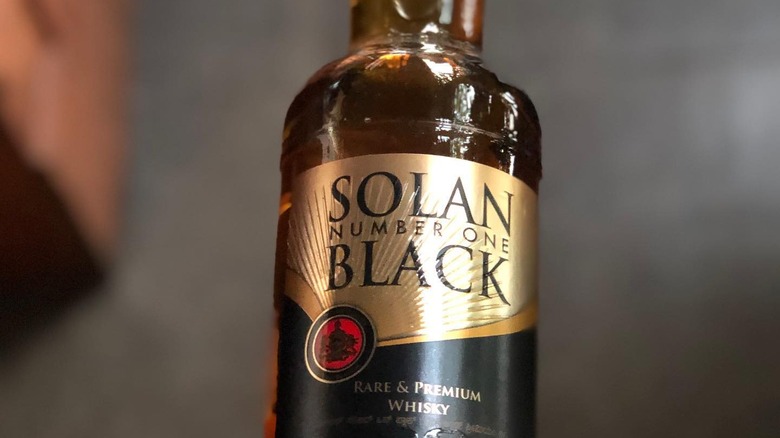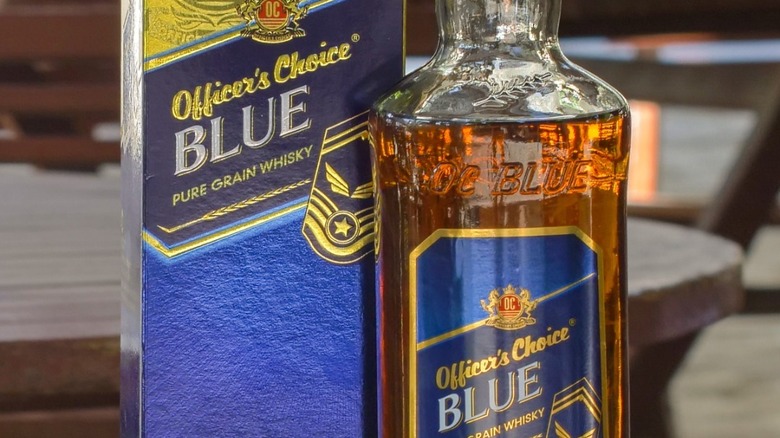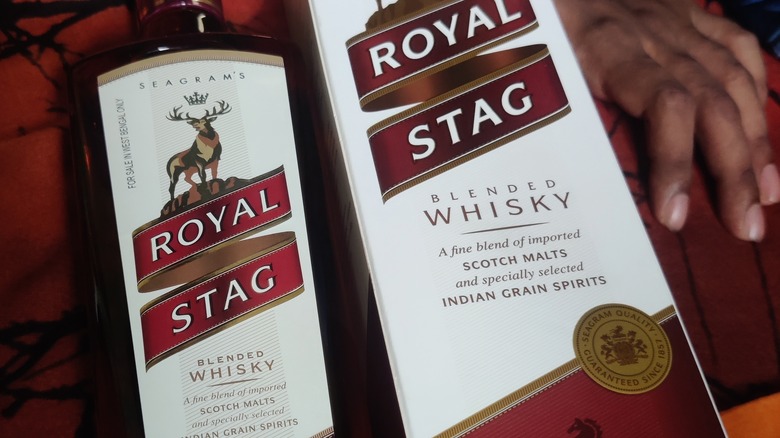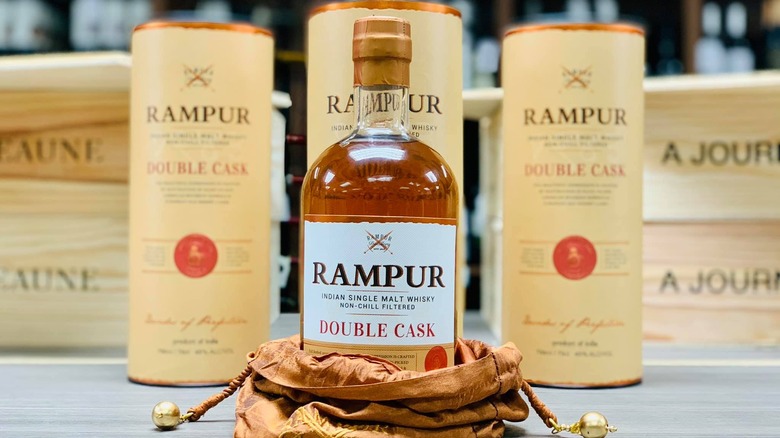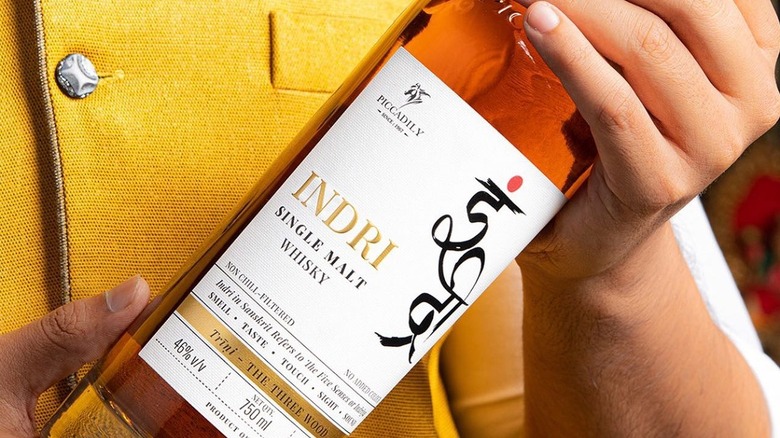12 Indian Whisky Brands, Ranked
While whisky has a long history in Scotland and Ireland, India's foray into whisky production is relatively more recent, with the industry taking significant strides over the past few decades. Different grains, varied climates, and innovative production techniques are contributing to a wide spectrum of taste profiles, ranging from fruity and spicy to sweet, rich, and complex, all conspiring to help make Indian whisky unique. There's also experimentation; several Indian distilleries have shown innovative approaches, experimenting with grains, cask types, and maturation techniques with creative results. We also need to take into account India's tropical climate, which significantly impacts the whisky maturation process. Unlike Scotland's cool, damp cellars, Indian distillers face the challenge of a hot and humid climate, which leads to an accelerated aging process. The whisky interacts intensely with oak barrels, extracting flavors and aromas at a quicker pace. This climatic influence imparts a distinctly rich and complex character to Indian whiskies.
Ranking Indian whiskies is a subjective enterprise, with personal preferences as well as the specific expressions and releases from different distilleries taken into consideration. Still, we can look at the aroma, taste, and finish of each whisky, as well as sweetness, spiciness, fruitiness, and complexity. In my time tasting Indian whiskies I've found them to be as surprising and delightful as whiskies I've had from Scotland, Japan, or anywhere else in the world. If you're a fan of the spirit, you should really be trying whisky from India. Here are our top Indian whiskies, ranked.
12. Solan No. 1 Black
The Himalayan Highlands is home to several distilleries, including Kasauli Brewery and Distillery, which has been producing Solan No. 1 for close to 200 years now. What was in the past India's most popular malt whisky is still produced using traditional Scottish methods, including the same copper pot stills that were used when the distillery was opened in the mid 19th century. They were brought there by businessman Edward Abraham Dyer, who was determined to produce a whisky as good as any from Scotland, but using local ingredients.
If you can find a bottle of the more recent offering Solan Black, you'll recognize many of the traits associated with other whiskies from the area. A quick sniff gives up citrus notes, as well as caramel and spices, but the initial taste will reward you with black pepper and cinnamon flavors. What really stands out is the orange, which hits you right off the top, nearly masking a hint of nutmeg. That orange flavor and general sweetness stick around through the warm burn at the back of the throat. Harder to find than many of the newer brands, it's also less distinctive in many ways. The best way to enjoy this whisky might be to give it a splash of water and see how it develops.
11. Imperial Blue Whiskey
It's possible that we wouldn't even be discussing Imperial Blue if it weren't for some genius marketing on the part of the whisky's owner, Pernod Ricard. Ever since 1995, India has banned all advertising of alcohol, but Pernod Ricard found a way to get around this in 2011 by commissioning and releasing what they called a feature-length film called Men Will Be Men. While promoted as a movie, it was a series of ads sunk into a casually sexist narrative. Needless to say, it was a huge hit in India and elsewhere, though recent years have seen it called out as toxic.
Aside from the controversy over this complicated ad campaign, you'll taste a touch of citrus on the nose as well as a hint of caramel. Imperial Blue's status as a cool kid blend hides the fact that, like many Indian whiskies, it also makes use of Scotch malts and Indian grains. This is a fine entry-level blend, and while it's acceptable as a sipping whisky it might be best used as an alternate choice for making Scotch cocktails.
10. Officer's Choice Blue Label
Another blended whisky in a market glutted with them, and a top-selling brand, Officer's Choice Blue Label made its debut in the Indian market in 1985, but only really made its mark in the mid-2000s during a relaunch. Since then, it has emerged as one of the leading whisky brands, carving a niche for itself in the country's spirits landscape. A blend of Indian grain spirits, this whisky has a mild nose, and grainy finish, with a hint of nuttiness, as well as strong notes from the charred oak barrels it steeps in.
There are few surprises to be found in this whisky, which has the appealing taste of fresh fruit, pepper, and vanilla coursing through each sip. It's triple distilled and thus quite smooth, and it's also sweeter compared to most of its rivals, with a slight hint of butterscotch at the finish. Its current status as one of the premier whiskies in the world of Indian spirits attests to some excellent marketing, but it's also a very good budget brand to have on hand for get-togethers. It's okay, placing it in 10th place.
9. McDowell's No. 1 Reserve Whisky
A blended whisky enjoyed as much for its accessibility as affordability, McDowell's may not be as complex as the vaunted single malts on the market but it's an easy-drinker redolent with dried fruits and spices on the nose. Swirl the glass and you'll pick up everything from warm vanilla and caramel to hints of oak and spice. This is a sweet whisky that may not appeal to everyone. That being said it's very versatile, whether sipped neat, on the rocks, or as a base for cocktails.
There's a velvety mouthfeel and a lingering finish in this golden-hued spirit, which makes use of imported scotch malts to augment locally produced whiskies. While it's not quite as distinctive as other Indian whiskies, it has some cachet in the world of entertainment. In the same way that Jack Daniels is the tipple of choice for many rockers, McDowell's No. 1 Reserve Whisky has become heavily associated with big Bollywood films.
8. Royal Stag Whisky
A mass-market whisky that is simple and smooth, Royal Stag is also very affordable compared to many other brands. Well balanced, with a touch of oak and sweet on the nose, it's one of the many whiskies under the banner of Pernod Rickard. Introduced to the Indian market in 1995, Royal Stag shot forward in global popularity due to its approachability and tastiness. Notes of ripe apples, pears, or other orchard fruits are apparent, as well as honey and caramel. The oak casks that the whisky matures in gives it a soft vanilla undertone.
There's a lot going on in this whisky if you allow it to linger on the tongue. Gentle hints of baking spices like cinnamon or nutmeg make their way through, and there's a sweet aftertaste that endures, leaving a pleasant and lingering impression. Royal Stag undergoes a triple distillation process, a technique that gives the product a smoother taste and a more subtle finish. It's also big in the cricket world, with marketers closely aligning the sport with the brand.
7. Sula Vineyards Eclipse
They say that there's nothing new under the sun, and while that might be true there is always something that tests the boundaries. Like Sula Vineyards Eclipse, which perked up ears in 2017 due to reports that it was a "grape wine-based whisky." This isn't completely accurate; Eclipse mixes grain spirit, malt Scotch, and peated malt spirit with a dose of grape spirit, which makes it unique but not quite the proposed wine-whisky synthesis. Still, it's an indication that Indian whisky makers are very interested in seeing just how far traditional methods can be stretched.
Surprise, surprise, Eclipse is a very fruit-forward whisky, light and smooth. It probably won't win over aficionados of smokiness or peatiness, though there is an element of peat due to the malt spirit. It's on the sweeter side, with a touch of vanilla, and the scent of citrus is quite pleasing. Can you taste the grape spirit? Hard to tell unless you're blind tasting, but there is something unusual going on here. This is a hard-to-find whisky, but well worth it if you're up for an adventure.
6. Royal Tiger Whisky
Goa is the party capital of India, so it probably comes as no surprise that some of the best spirits in the country are also produced there. Feni is the drink of choice in the southwestern state, but there are a few whiskies that have made their mark, including Royal Tiger Whisky. There's a certain aristocratic flair to Royal Tiger, likely because the water that they use comes from a spring on master distiller Craig Henriques' private estate, but it's also in the elegance of the whisky itself.
Royal Tiger is peated, but not excessively so, and beautifully structured with elements of smokiness and an almost vanilla taste intertwining through. You'll pick up a lot in this one, from a subtle nuttiness to an earthy finish, a tinge of citrus, and even coffee. Produced from grains sourced at the foothills of the Himalayas, Royal Tiger is matured and double-barreled in charred oak barrels, giving it a delicately burnished finish.
5. Kamet Indian Single Malt Whisky
Master blender and distiller Surrinder Kumar looms large in the current whisky scene. Not only did he help set Amrut on the path to success and craft Indri-Trini Single Malt into an award-winning product, but he's also part of the team that has given us Kamet Indian Single Malt Whisky, named after the third largest mountain in the area. Distilled in pot stills at Piccadilly Distillery in Karnal, Haryana, this single malt takes from the Kumar playbook and also makes use of bourbon, wine, and sherry casks as part of the maturation process, along with 6-row barley from the region.
This is a delicate and sweet whisky, fruity with chocolate and caramel notes. It's non-chill filtered, and it's not artificially colored. There's a spicy finish to it, and a smell of citrus just as you're tipping forward for your first sip. Add water if you must, but this one begs to be drank neat.
4. Rampur Indian Single Malt Whisky
A relatively recent entrant into the world of Indian spirits, Rampur Indian Single Malt Whisky is crafted at the Radico Khaitan Distillery, which is situated in Rampur, a city in the Indian state of Uttar Pradesh. Launched in 2016, the single malt uses local Indian barley and undergoes distillation in copper pot stills, a traditional method often associated with the production of premium whiskies. This process is known for its ability to impart nuanced flavors to the spirit.
Matured in oak barrels, Rampur Single Malt is a delight on the tongue, with fruity, spicy, and oaky notes. Vanilla, honey, and a subtle hint of spices are also part of the flavor profile, helped along by the process of non-chill filtration. This means that the whisky retains more of its natural oils and flavors, enhancing the overall mouthfeel and preserving the integrity of the spirit. Complex and rich, it's nudged past quite a few Scotches as a top 10 tipple.
3. Paul John Single Malt
Goa, India's smallest state, gives us Paul John Single Malt Whisky, a single malt that has picked up a fair amount of acclaim in just a decade of operation. The distillery uses six-row barley sourced from the foothills of the Himalayas, giving the whisky a robust flavor profile. Environmental conditions in Goa play a significant role in shaping the whisky's character. It's a hot and tropical climate, which accelerates the maturation process, resulting in whiskies that exhibit remarkable depth and complexity in a relatively short time. The angel's share, the portion of whisky that evaporates during maturation, is notably higher in Goa compared to more temperate regions, which contributes to the concentration of flavors in each bottle.
Paul John Single Malt offers a range of expressions, each with its distinctive character. Among them is Brilliance, an elegant offering with notes of honey, tropical fruits, and a touch of spice, while Edited introduces an appealingly subtle peatiness and a distinctive flavor profile. Also of interest is the use of different cask types, including American oak and sherry casks, which impart a range of flavors and aromas from vanilla and toffee to dried fruits and oak spices.
2. Indri-Trini Single Malt
The world of whisky is always looking for the next big thing, and for many that would be Indri-Trini Single Malt, a peated single malt matured in sherry casks. Overseen by former Amrut master blender and distiller Surrinder Kumar, the company has been making waves for a few years now, recently winning big at the 2023 Whiskies of the World Awards this October with their Indri Diwali Collector's Edition 2023, which claimed the prestigious Best in Show, Double Gold Award. That whisky isn't yet available in markets, but you can still find the acclaimed Indri-Trini Single Malt for a pretty decent price considering the critical accolades showered on it.
There's baking spice and oak on the nose, with pineapple and lychee peeking out in that first sip. Let it roll around in your mouth and you'll be rewarded with a touch of cinnamon and tropical fruit. Three casks are involved in the process of maturation, with bourbon, red wine, and sherry aiding and abetting in the final taste as our tastebuds will allow us.
1. Amrut Fusion Single Malt
The first Indian single malt, according to Distiller, is hugely acclaimed for its rich and fruity taste, with mango notes, and smoky, peppery undertones. Produced by Amrut Distilleries, a pioneering Indian distillery located in Bangalore, Fusion blends Indian and Scottish barley with water sourced from the Himalayan foothills. The intense tropical climate of Bangalore, characterized by high temperatures and humidity, accelerates interaction between the spirit and the oak casks, resulting in a faster and more dynamic aging process. Maturation occurs in a combination of new American oak and ex-bourbon casks, which impart a rich and complex flavor profile to the whisky. The use of peat in the malting process adds a subtle smokiness, reminiscent of traditional Scottish whiskies, while the Indian barley imparts a unique tropical fruitiness.
There's a rich golden hue to Fusion, and the nose has hints of apple, and mango, plus a touch of citrus, complemented by the gentle waft of peat smoke. Stay with it long enough and you'll taste the sweetness of vanilla and toffee, followed by the warmth of cinnamon and cloves. a lingering impression of oak and a subtle hint of the peat smoke that characterizes this exceptional single malt, all of which make it our No. 1 pick.
